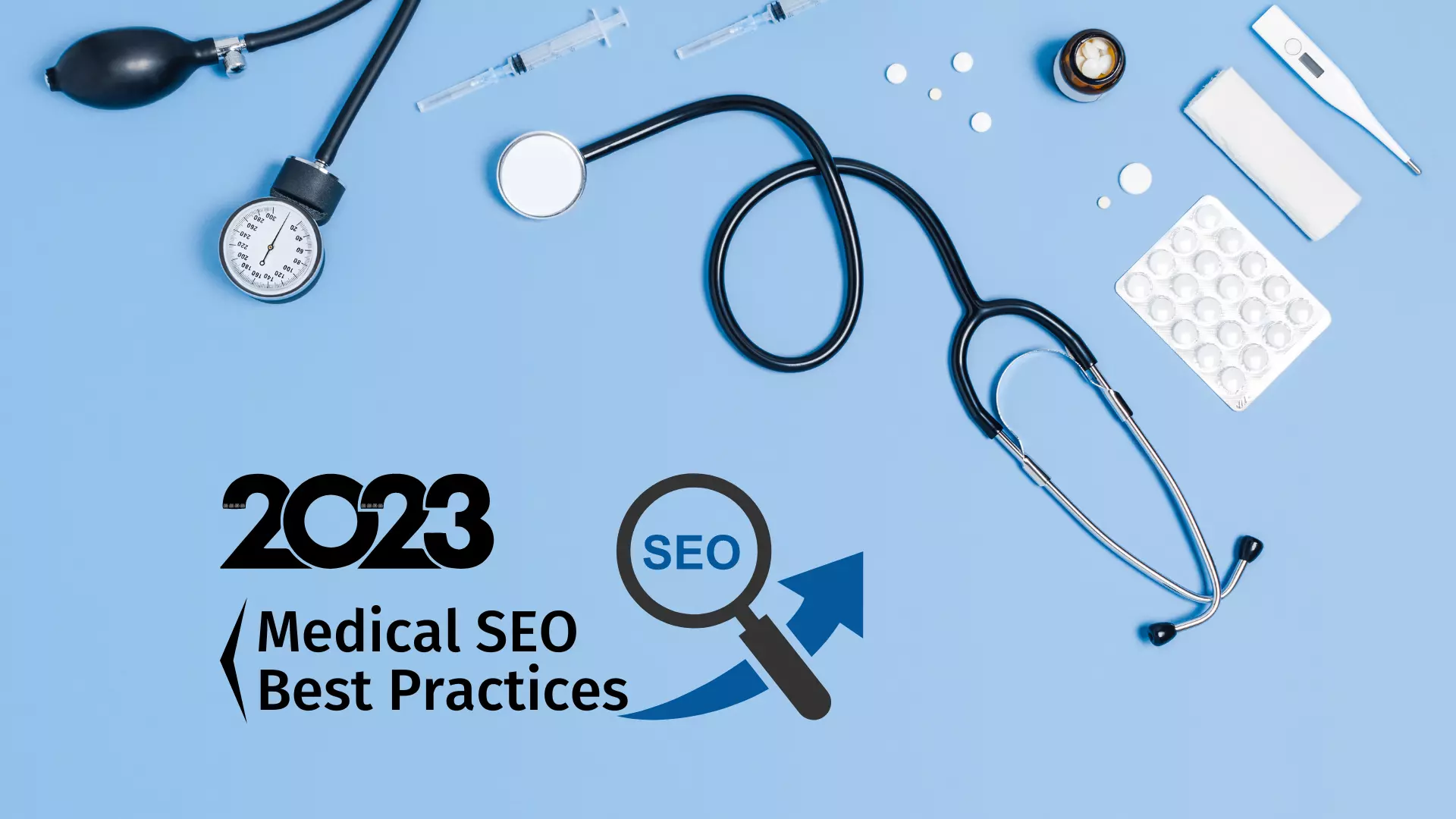Healthcare content is a growing and highly competitive online niche. As such, medical SEO for doctors and hospitals is an invaluable partner in online ranking. Many factors are involved in good medical SEO. However, not every single one of them is immediately important.
No matter what industry you’re in, chances are good that SEO services can help your business. Search engine optimization is all about making sure that your website appears as high up in the search results as possible. This can be a difficult feat to accomplish on your own, which is why many businesses choose to hire an SEO company to do it for them.
In this guide, we’ll go over the basics. We’ll cover the essential factors you can work on right now. For convenience, we divided this content into three sections: on-page, technical, and off-page medical SEO.
Table of Contents
Upgrade Content Through On-Page SEO
On-page search engine optimization (SEO) means applying changes to website elements. The goal is to rank well on search engine results pages (SERPs) and increase website visibility.
From content quality to keyword accuracy, there are many SEO factors you can influence on a single page. You don’t necessarily have to score perfectly on everything. However, it’s good medical SEO to address as many of these as possible.
Know Your Audience
The best way to start medical SEO is by conducting market research. Healthcare content marketing is a growing area of interest. Gathering as much information as possible gives you the best chance at success.
Here are three concrete steps you can take now for your market research:
- Size up the competition: Do a thorough competitor analysis. Learn about existing industry standards and other information you can use to your advantage.
- Learn your target market: Conduct surveys, studies, and focus groups. Identify pain points and information gaps that you can confidently address.
- Find and establish your niche: Apply what you’ve learned through competitor analysis and market research. Remember, there is always a gap you can lean into.
Do Keyword Research
Once you have identified your target market, begin keyword research. Google, Google Trends, and Google Search Console are fantastic (and free) tools for in-depth analysis. About two-thirds of the U.S. desktop search queries take place on Google, so optimizing for this search engine and leveraging its tools makes sense.
Several types of keywords can serve your content well.
- Long-tail keywords: Search queries for medical concerns are usually more specific, so investing in multiword keywords will yield better results for your content.
- Location-based keywords: Medical needs are immediate, so ranking high in local search is highly profitable. When making local city pages, aim to rank for searches related to your immediate and surrounding cities.
- Most searched keywords: Regularly review trending and popular topics for keywords and content ideas. Remember to use similar but lower-volume keywords for your content. Doing so helps improve your ranking in search engines.
If you want to do keyword research, there are a few different keyword research tools you can use. Google AdWords Keyword Planner is one of the most popular options. This tool allows you to enter a keyword or phrase and see how many people are searching for it each month.
You can also use Google Trends to see how popular a keyword is over time. This can be helpful to see if a particular keyword is becoming more or less popular so you can adjust your strategy accordingly.
Finally, the Google Search Console can also provide some insights into keywords that people are using to find your website. This information can help you determine which keywords you should be targeting in your SEO efforts.
Create Quality Content
The following content types work well with medical SEO and healthcare content:
- Blog posts: are easy to write and consume. That’s why they are suitable for making healthcare content more relatable and exciting. They excel at drawing attention and maintaining engagement.
- Video posts: make boring content exciting and help build rapport with potential customers. Create explainer videos, staff profile videos, and customer testimonials.
- Visual content: like infographics, charts, and tables are just as valuable online as in a doctor’s office. Help your clients quickly and clearly understand critical information with concise bullet points and relevant statistics.
To get the most out of your content, you must be:
- Concise when making content. If it’s not necessary to your point, leave it out.
- Proactive in helping your readers. Add a call-to-action (CTA) for the next step to follow.
- Natural in your use of keywords. Don’t add keywords where they don’t fit.
- Consistent in your use of keywords. Include them in headers and subheaders.
- Relevant to your ideas. Write for your client’s specific needs and write with authority.
- Mindful of your content. Be sure to update your website with fresh content.
- Direct when addressing topics in your content. Aim to become a featured snippet.
Marketers today are under more pressure than ever to produce results. With the rise of content marketing, many marketers have turned to this strategy in an effort to connect with their audience and drive results. However, content marketing is not without its pitfalls. In fact, there are a number of common content marketing mistakes that marketers make when it comes to content marketing.
Use Links Effectively
Links can affect your SERP ranking in three ways.
- Internal links, or links between your website’s pages, make your website more crawlable and show your expertise and authority on a given topic.
- External links, or links from your website to another, show how well you make your content through source references. For example, external links to sites with high domain authority (DA), like Forbes, show that your content is well-researched.
- Backlinks, or links from another website to your pages, show how valuable your content is as a reference to other content creators.
However, not all backlinks are good links (more on this later). If you’re looking to build links to your website, there are a few strategies you can use to get started. One popular method is to create content that is shareworthy and informative, as this can encourage other websites to link back to your site. Additionally, guest posting on high-quality blogs and websites can also help you earn backlinks.
Whichever backlinks creation strategy you choose, be sure to put in the time and effort needed to see results. With a little patience and perseverance, you can soon start seeing an increase in traffic and rankings thanks to your newly earned backlinks.
Just like when using keywords, incorporate links with care. Be wary of who you link to and who links back to you. Linking can positively or negatively impact your SEO score.
Review Your Analytics
To improve your website’s performance, figure out what works and what doesn’t. Follow these steps to get the most out of your analytics.
- Set and manage KPIs: Key performance indicators (KPI) help you track whether your site performs below, above, or at the standard you want. Set clear, achievable goals and review them regularly against your analytics.
- Review your on-page SEO: Check how well you have done SEO on a specific page. Most content management systems (CMS) and SEO tools do this automatically. They provide ratings that show areas for improvement.
- Fix on-page SEO issues: Once you have identified errors in your on-page SEO, do what you can to address them. Again, SEO tools can help.
- Measure SEO impact: Track your website and content performance consistently. Note the SEO changes you have made and their effect on your metrics.
- Check traffic and conversion rates: Identify which content attracts traffic to your website and through which channel (i.e., search, social media, ads, backlinks, etc.). Compare your findings against your KPIs. Then rinse and repeat.
Attract Search Engines with Technical SEO
Technical SEO means applying changes to site elements on the backend. They are still within your site but are not as readily changeable as on-page aspects.
Optimizing for crawling and indexing falls under this umbrella. User experience is another element of technical SEO that greatly impacts your ranking.
Technical SEO involves optimizing site elements on the backend, including crawling, indexing, speed, mobile-friendliness, site structure, and schema markup. User experience is also important. Unlimited residential proxies can be used to improve SEO efforts and avoid spam detection.
Make Your Site Crawlable and Indexable
Many factors affect how desirable your content is as a search result. Let’s group them into aspects that affect them: crawlability and indexability.
When search engine bots crawl your website, they look through the following “hidden” data:
- Internal links: Website crawlers can only find pages connected to other pages on your site. Solid internal links make your website easier to crawl and index.
- Broken links: If a crawler reaches a broken link, it gets a dead end. It then registers an error. Avoid potential issues by reviewing links periodically.
- Website activity: Regular uploads and updates to your website encourage crawling. Meanwhile, old or dead pages (ones you have neglected) turn away crawlers. Turn off crawling and indexing for these pages as much as possible.
Create a sitemap and submit it to search engines. Doing so helps make your website easily crawlable and indexable.
Meanwhile, some factors also affect how likely your website will appear on the SERP.
- Loading time: Search engines prefer websites that load fast. They perceive such sites as being able to provide a smoother user experience.
- Website design: Websites optimized for mobile use get favored. Google’s mobile-first indexing prioritizes the mobile experience.
Also, boost your crawlability and indexability with metadata or data that provides further information about your website elements. Metadata makes it easier for search engines to understand your content quickly. The following are some of the metadata search engines seek.
- Title metadata
- Description metadata
- Keyword metadata
- Image metadata
Most CMS and SEO plugins or tools make changing your page’s metadata easy. Take advantage of this every time you publish new content.
Optimize Your Site for UX
As mentioned above, user experience (UX) can make or break your SEO success. Here are some guidelines to ensure you provide a great user experience:
- Write short, simple sentences. Use conversational language to improve readability.
- Avoid technical terms as much as possible. When using jargon, provide an explanation.
- Break up your content into sections and break your sections into short paragraphs.
- Insert pictures, videos, or infographics to simplify challenging topics.
- Install an easy-to-use search bar and make navigating your website intuitive.
- Use sidebars, menus, and tags to make relevant and related content easy to find.
- Keep your web pages clean. If users can’t find what they need quickly, they will leave.
- Use images strategically to create a welcoming environment for visitors.
- Heavy files can slow down your website. Optimize images for faster load times.
- Allow users to post comments or provide feedback on your business or services.
Make Your Website Marketable with Off-Page SEO
As the name suggests, off-page SEO is everything that happens outside your website that can affect your SERP ranking. It includes branding (domain name), backlinks, marketing strategy, and more.
Effective off-page SEO means making these factors work to improve your score and ranking online. Plenty of free and paid advanced SEO tools can analyze your website’s off-page SEO performance.
Aim for Brand Recognition
It might not seem obvious, but a brand name hugely impacts marketing success. Choose a short, unique, and memorable brand (and domain) name. Search engines and users don’t like long URLs, and this helps keep them short.
Say you have a honey farm. A good brand and domain name would be “Buck’s Honey” instead of “Buck’s Natural and Organic Honey Farm”.
Another factor that affects your branding is E-A-T, which stands for expertise, authority, and trustworthiness.
- Expertise refers to how knowledgeable you are on the topics covered on your website.
- Authority refers to how much authority you and your content hold in your field.
- Trustworthiness refers to how much users can trust you, your content, and your website.
Clean Up Your Backlinks
Search engines can tell if backlinks to your site are natural or artificial. They confirm this by reviewing both websites and comparing how similar or related they are.
For example, for the website of a Miami hospital, good medical SEO would mean receiving backlinks from health and wellness websites, medical blogs, and the like. If the same website has many backlinks from fast fashion bloggers, it will appear suspicious.
Search engines penalize websites that try to manipulate SEO by buying backlinks, especially from sources unrelated to the website and with a low authority score.
Maximize the impact of backlinks by doing the following:
- Check your backlinks for relevance and quality using Google Search Console. List the links you don’t want and take steps to remove them. One way to do this is by contacting the linking website.
- Earn natural backlinks from other websites in the same industry as you. It shows that your content is well-made and holds authority. An easy way to get backlinks naturally is by connecting with others in your field and making meaningful collaborations.
- Leverage your content to get natural backlinks from different channels. Well-made content can attract attention on its own. Take this to the next step by asking for attribution. This method works well with videos, images, and infographics.
Just like you need a strong foundation to build a house, your website needs a strong backlink base. But sometimes, things can get out of hand and you can end up with a link profile that’s full of low-quality or even toxic links.
When that happens, you need to use backlink removal tools to clean up your link profile and protect your website from Google penalties.
Create Effective Marketing Strategies
When marketing your website, there are several options to choose from. A marketing campaign’s effectiveness depends on several factors, including content, strategy, and budget.
Ask yourself: How well does my marketing strategy complement my content? How well did I implement my marketing strategy? How much am I willing to spend on my marketing strategy?
Here are some strategies to try.
Email marketing: is a free and readily available marketing option. It may seem outdated, but emails can still be effective. Make sure your receipts are open to email marketing. Then, send a concise email with everything they need to know about your website.
Social media marketing: is another low-cost option. Creating an account is free and simple. More importantly, almost everyone’s on social media. Facebook alone has 2.93 billion users, making it an ideal digital storefront for doctors and hospitals.
Video marketing: is not only for online video platforms. Publishing video ads and profiles on your website can work just as well, primarily when used as backlinks to your website.
Summing Up
Mastering medical SEO is a long and challenging process, but follow the tips above and you’re already halfway there. If you want to unburden yourself, plenty of tools and companies can smooth the process and help you achieve and maintain good SEO for your website.
This content is contributed by Marina Turea works as a content manager at Digital Authority Partners.



















